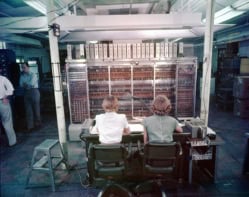Fermi Remembered
James W Cronin (ed)
2004 University of Chicago Press 296pp $45.00hb

November 1954, Billings Hospital, Chicago. The great physicist Enrico Fermi is ill in bed, his life in a hopeless situation. His colleagues Subrahmanyan Chandrasekhar and Herb Anderson pay him a visit, and are at a loss for words. Fermi senses this and puts them at ease.
“Tell me, Chandra,” he asks, “when I die, will I come back as an elephant?”
Having broken the ice, the conversation proceeded smoothly.
This anecdote, which is recounted by the Nobel laureate Jerome Friedman, is one of many reported by Fermi’s students in Fermi Remembered. Friedman was just one of 10 Nobel-prize winners to have been students or lecturers under Fermi’s tutelage at the University of Chicago. As Friedman himself writes, “Fermi was truly a remarkable man in all respects.”
Born in Rome in 1901, Fermi was the last universal physicist – the most extraordinary of his century. He was at home in the workshop, the laboratory and among theoretical physicists. For the theorists he was a great theorist, and for the experimentalists he was a great experimentalist. What made Fermi so special as a physicist was his universality and versatility; what made him so special as a person was his modesty, realism and frugal lifestyle.
This book, which describes Fermi’s contributions to physics and the US period of his life, originated from a symposium that was held in Chicago in 2001 to commemorate the centenary of his birth. But it is not merely a volume of reminiscences. It combines essays, specially commissioned articles, as well as private material from Fermi’s research notebooks, correspondence and speeches. Together the material highlights the breadth of his impact on physics.
A classic biographical introduction by Emilio Segrè is followed by an article in which Frank Wilczek, who shared the Nobel Prize for Physics last year, puts into perspective Fermi’s huge contributions to physics. The list of his achievements is impressive. They include the introduction of Fermi statistics for half-integer-spin particles (1925) – now called fermions – that led to the concept of the “Fermi surface” in condensed-matter and nuclear physics; the vector-coupling theory for beta-decay (1933), which formulated the proper structure of the weak interaction where the “Fermi constant” measures the strength of the coupling; and the introduction, with his Rome group, of neutron-induced radioactivity and the study of slow-neutron interactions (1934).
In 1938 Fermi was awarded the Nobel Prize for Physics for “his demonstration of the existence of new radioactive elements produced by neutron radiation and for his related discovery of nuclear reaction brought about by slow neutrons”. However, in the same year Mussolini’s Fascist racial laws directly affected his wife Laura, who was Jewish. This fact – and his deep resentment of an injustice that offended his sense of fairness – convinced Fermi to leave Italy. After picking up his Nobel prize in Stockholm he travelled directly to New York to begin the second great period of his life.
Once in the US, Fermi’s achievements continued with the construction of the first controlled, self-sustaining nuclear reactor in Chicago in 1942. He also played a leading role in the wartime Manhattan atomic-bomb project at Los Alamos that led to the first self-sustained nuclear reaction and hence to the production of electric power and plutonium for atomic weapons. He later developed a theory for cosmic-ray acceleration and studied π-mesons and the π-interaction. Fermi died shortly after his 53rd birthday on 28 November 1954.
The articles by Fermi’s research colleagues and students tell us of his work in the US at Columbia, Los Alamos and Chicago. Although they discuss some aspects of the nuclear reactor at Chicago – and of his years at Los Alamos – the focus is very much on his Chicago days from 1945 to 1954. As the book’s editor James Cronin puts it, there was “no better physics department in the world” during this time. Cronin is another of Fermi’s students who went on to win a Nobel prize, and he concludes the book with an essay that compares Fermi’s prediction for the future of particle physics with what actually happened. The predictions, which Fermi referred to as “looking into a crystal ball”, were remarkably accurate. He felt that particle physics was on the cusp of a golden age, and that the key would be the development of new accelerators operating at higher energies.
Fermi’s outstanding scientific stature shines through in many of the contributions, as does his methodical and dedicated approach to physics. He was a “physics machine” who showed great humanity towards his students, family and friends. Many of the recollections, anecdotes and documents contained in the book will be relevant to historians of physics. Some even reveal unknown aspects of Fermi’s character. Who knew, for instance, that he enjoyed the Li’l Abner comic strips, as Murray Gell-Mann reveals?
As a researcher and a teacher, Fermi inspired two generations and two continents – a man whose charismatic nature attracted many talented scientists and students to Chicago. What emerges from this book is the gratitude of so many extraordinary physicists to their master, who instilled in them a passion that has lasted a lifetime: the passion for physics.


